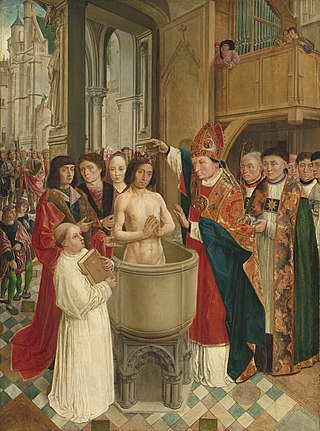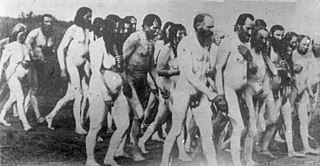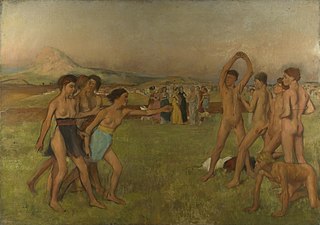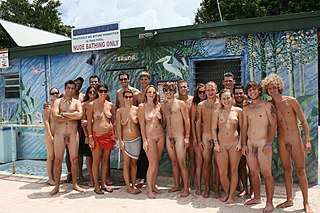
Naturism is a lifestyle of practicing non-sexual social nudity in private and in public; the word also refers to the cultural movement which advocates and defends that lifestyle. Both may alternatively be called nudism. Though the two terms are broadly interchangeable, nudism emphasizes the practice of nudity, whilst naturism highlights an attitude favoring harmony with nature and respect for the environment, into which that practice is integrated. That said, naturists come from a range of philosophical and cultural backgrounds; there is no single naturist ideology.
Ed Lange was a nudist photographer, and a publisher of many nudist pamphlets and magazines showing the nudist lifestyle.
Kurt Barthel (1884–1969) is the father of the modern United States nudist movement.
Clothing laws vary considerably around the world. In most countries, there are no laws which prescribe what clothing is required to be worn. However, the community standards of clothing are set indirectly by way of prosecution of those who wear something that is not socially approved. Those people who wear insufficient clothing can be prosecuted in many countries under various offences termed indecent exposure, public indecency, nudity or other descriptions. Generally, these offences do not themselves define what is and what is not acceptable clothing to constitute the offence, and leave it to a judge to determine in each case.

Freikörperkultur (FKK) is a social and health culture that originated in the German Empire; its beginnings were historically part of the Lebensreform social movement in the late 19th century. Freikörperkultur, which translates as free body culture, includes both the health aspects of being naked in light, air and sun and an intention to reform life and society. It is partly identified with the culture of nudity, naturism and nudism in the sense of communal nudity of people and families in leisure time, sport and everyday life.

Christian naturism is the practise of naturism or nudism by Christians.

Social nudity is the practice of nudity in relatively public settings not restricted by gender. This occurs both in public spaces and on commercial property, such as at a naturist resort.

Nudity in religion deals with religious beliefs as the basis for modern attitudes and behaviors regarding nudity.
Gymnosophy was a movement and a philosophy practiced in Europe and the US from the end of the 19th century to the mid 20th century. The practice involved nudity, asceticism, and meditation.

Nudity is sometimes used as a tactic during a protest to attract media and public attention to a cause, and sometimes promotion of public nudity is itself the objective of a nude protest. The practice was first documented in the 1650s with Quakers "naked as a sign" practice. Later the tactic was used by svobodniki in Canada in 1903, and photographs of their nude protests have been published. The tactic has been used by other groups later in the century, especially after the 1960s. Like public nudity in general, the cultural and legal acceptance of nudity as a tactic in protest also varies around the world. Some opponents of any public nudity claim that it is indecent, especially when it can be viewed by children; while others argue that it is a legitimate form of expression covered by the right to free speech.

Nudity is the state of being in which a human is without clothing. While estimates vary, for the first 90,000 years of pre-history, anatomically modern humans were naked, having lost their body hair and living in hospitable climates. As humans became behaviorally modern, body adornments such as jewelry, tattoos, body paint and scarification became part of non-verbal communications, indicating a person's social and individual characteristics. Indigenous peoples in warm climates used clothing for decorative, symbolic or ceremonial purposes but were often nude, having neither the need to protect the body from the elements nor any conception of nakedness being shameful. In many societies, both ancient and contemporary, children might be naked until the beginning of puberty. Women may not cover their breasts, being associated with nursing babies more than with sexuality.
The American Gymnosophical Association (AGA) was organized circa 1930 by Herman and Katherine Soshinski. It was one of 3 spin-off groups from the League for Physical Culture that had been organized by Kurt Barthel in 1929. Dr. Maurice Parmelee, Professor of Sociology, City College of New York was its honorary President.

This timeline of social nudity shows the varying degrees of acceptance given to the naked human body by diverse cultures throughout history. The events listed here demonstrate how various societies have shifted between strict and lax clothing standards, how nudity has played a part in social movements and protest, and how the nude human body is accepted in the public sphere.
Naturism has been active in France since 1920.
Naturism is a cultural and social movement practicing, advocating and defending social nudity in private and in public. It is particularly strong in Germany where it goes under the name Freikörperkultur (FKK). It refers to a lifestyle based on personal, family and/or social nudism in the "great outdoors" environment. Naturism grew out of the German Lebensreform movement and the Wandervogel youth movement of 1896, and has been adopted in many neighbouring European countries and was taken by the German diaspora to North America and other continents.

The history of yoga in the United States begins in the 19th century, with the philosophers Ralph Waldo Emerson and Henry David Thoreau; Emerson's poem "Brahma" states the Hindu philosophy behind yoga. More widespread interest in yoga can be dated to the Hindu leader Vivekananda's visit from India in 1893; he presented yoga as a spiritual path without postures (asanas), very different from modern yoga as exercise. Two other early figures, however, the women's rights advocate Ida C. Craddock and the businessman and occultist Pierre Bernard, created their own interpretations of yoga, based on tantra and oriented to physical pleasure.

Marguerite Agniel was a Broadway actress and dancer, who then became a health and beauty guru in New York in the early 20th century. She is known for her 1931 book The Art of the Body: Rhythmic Exercise for Health and Beauty, one of the first to combine yoga and nudism.

A naturist resort or nudist resort is an establishment that provides accommodation and other amenities for guests in a context where they are invited to practise naturism – that is, a lifestyle of non-sexual social nudity. A smaller, more rustic, or more basic naturist resort may be called a naturist camp.
Naturism in Argentina is the movement supporting the practice of social nudism in the country, which began to be regularly performed in 1934 and it is being practiced nowadays, despite still being a taboo topic in the Argentine society. The most important nudist destinations include Escondida Beach, Querandí Beach and Eden club in Buenos Aires Province, as well as Yatan Rumi in the Córdoba sierras.














